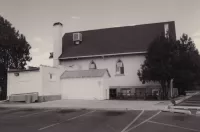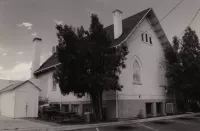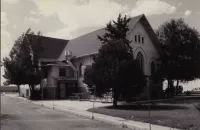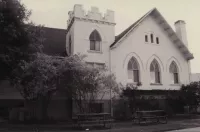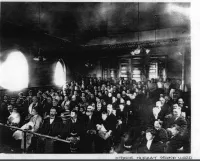Share what you know,
and discover more.
Share what you know,
and discover more.
May 08, 2001
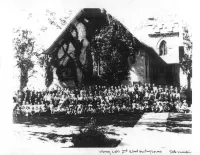
-

- Charmaine Bantugan
National Register of Historic Places - Murray LDS Second Ward Meetinghouse (Alano Club)
Statement of Significance: Built in 1909, the Murray LDS Second Ward Meetinghouse is significant under criteria A and C as part of the multiple property submission Historic Resources of Murray City 1850- 1950. Under Criterion A, the meetinghouse is significant for its association with the historic context of "Religious and Social Buildings of Murray." Under Criterion C, it is significant as a well-preserved example of a meetinghouse influenced by the Gothic Revival style, a popular style for Mormon meetinghouses in the Salt Lake Valley during the first decade of the twentieth century.2 The Murray Second Ward Meetinghouse has received little exterior alteration. The building retains its historic architectural integrity and is a contributing historic resource of Murray, Utah. History Murray City lies eight miles south of Salt Lake City between Big and Little Cottonwood Creeks. It is named for Eli Murray, territorial governor from 1880 to 1886. Murray was settled in 1849 as part of the initial expansion south of Salt Lake City. Early residents of the area divided the grasslands into homesteads or parcels where they raised cattle and cereal grains. Most of the cattle provided dairy products, whole wheat, corn, and some rye were grown to feed the family and animals. Despite an agricultural beginning, Murray quickly developed into an industrial community. In 1852 the Bingham brothers discovered silver and gold ore in the Oquirrh Mountains to the west. As LDS church leader Brigham Young discouraged Mormons from mining, it was not until the arrival of Col. Patrick E. Conner in 1862 that the mining boom began. Conner and his men left California and arrived in Utah with "gold fever"; the volunteer soldiers were eager to prospect in the mountains surrounding the Salt Lake Valley.3 With the abundance of ore in both the Wasatch and Oquirrh Mountains, mining-related industries were soon established. The arrival of the Utah Southern Railroad in 1871, and the Denver & Rio Grande in 1881, virtually guaranteed the growth of the smelter industry in Murray. Construction of the Woodhull Brothers' smelter in 1869 initiated Murray's industrial history. Murray produced the first silver bars smelted in Utah in 1870. Business and commercial enterprises prospered along with the smelter industry. The smelters continued to dominate the local economy until 1950 when the ASARCO lead smelter, the city's largest employer, closed. Murray was praised as a shining example of cooperation between business, industry, and government in the early twentieth century; it was hailed for having its own water plant, lighting system, smelter, canning factory, flour mills, and brickyards. By 1880 the small town of scattered farmsteads boasted a small commercial business district located on State Street between Vine Street and 4800 South. Its central-valley location and plentiful water have allowed Murray to evolve from an agricultural to an industrial and suburban community. Industries in Murray were hit hard by the 1930s Depression. The smelters began to close in 1931, and major industry had all but disappeared by 1940. Murray City took advantage of the new federal projects, and the Works Project Administration (WPA) was responsible for many public improvements between 1930 and 1940. The city was well organized, and with clear goals, officials actively sought federal money to refurbish public buildings as well as its twenty-two-acre park. Unfortunately, in the years between 1930 and 1950 the smelters, brickyards, and mills that fueled the industrial economy had either closed down or moved. Community Development & Social History The small town of Murray was originally included in the boundaries of the South Cottonwood LDS Ward.4 Drawn in 1848, the boundaries extended south from Big Cottonwood Creek to the Point of the Mountain or the physical southern boundary of the Salt Lake Valley; and east from the Jordan River to the Wasatch Mountains. Most of the LDS settlers lived on farms located many miles from each other; due to this dispersion they rarely assembled for purely social occasions. Usually, their only interaction was at the weekly gathering at the meetinghouse. In pioneer Utah, the ward was more than the basic ecclesiastical unit; it was also the community's primary social and political system. In addition to regular Sunday and other ecclesiastical meetings, the meetinghouse was used for socials, dances, and plays. This multi-purpose role was consistent with the partially theocratic society under which the Mormons governed themselves in the early years. There was no distinction between church and state, all community activities were done in one form or another under the aegis of the church. The first LDS or Mormon meeting house in Murray was built in 1856; constructed of adobe bricks, it was located at the corner of 5600 South and Vine Street. As in most pioneer LDS communities, the first meetinghouse was vernacular classical in style and was built with the nearest and most available materials.5 It was understood that in time, a larger, more substantial facility would replace this first building. In communities that did not have a temple or tabernacle, the ward meeting house was the primary physical symbol of their relationship with God; it was a common element within the Mormon concept of sacred space. Many of the men employed at the Francklyn and Germania smelters were immigrants from Scandinavian countries who had joined the LDS church in their homeland and moved to Utah; most spoke very little English. In 1883 Bishop Rawlins of the South Cottonwood Ward allowed the Scandinavian population to hold separate services in the Swedish language. At first, the group met in the homes of various members; by 1893 the group had built a small wood frame meeting house located "west of the state road".7 This became known as the "unofficial" Scandinavian Ward. In 1900 there were 3,302 residents in Murray. On October 28, 1900, the Murray Ward was formally organized as an outgrowth of the South Cottonwood Ward, and Uriah G. Miller was appointed as the first Bishop. Six years later, on March 4, 1906, the ward was divided, creating the Murray First Ward and Murray Second Ward; Jacob E. Erekson was Bishop of the Second Ward. The geographic boundaries of the Murray Second Ward included the area west of the Oregon Short Line railroad tracks to the Jordan River and between the north and south Murray City limits. By 1910 the population in Murray had increased to 4,057; the next ten years brought 527 more residents to Murray, and by December 31, 1930, there were 5,172 residents. The Murray First Ward had 1,260 members; twice that of the Second Ward which had 675 members. The Murray First and Second Wards combined boasted 1,935 members of the LDS Church; this was 38.5 percent of Murray's entire population. The newly created Second Ward held their meetings in the twenty-foot by thirty-five-foot wood frame meeting house built by the Scandinavians in 1893. Almost immediately, steps were taken towards establishing a new meetinghouse. On September 10, 1906, a one-and-one-half-acre parcel was purchased from Peter Adamson for $400.00; the property was located on the west side of Second West Street (now Third West Street).9 In 1909, the new brick meetinghouse was completed; it was formally dedicated in 1911. With seating, fixtures and musical instruments, etc., the price of the new facility came to $13,000.00. The floor plan is in the shape of a T; the stem of the T (or front) was used for assembly and services, while "amusements" were located in the (rear) section perpendicular to the chapel.10 The old "Scandinavian" meetinghouse continued to be used as a storage facility. According to the 1933 Stake Report, during the months of November and December the chapel, amusement hall, and classrooms were renovated. The exterior wood trim was painted, and the interior wood trim was re-varnished. The ceiling in the auditorium was painted, and the walls and ceilings in the chapel and amusement hall were replaced, painted , and "starched". The walls in the classrooms were "re-calcimined", the boiler was overhauled and new flues were installed, and new linoleum flooring was laid in the front entrance hall. The total expense for this work was $1,359.46. The 1940 Stake Report reveals that a new floor was laid in the chapel and classrooms, and plans were made for new seating in the chapel. From 1942 to 1948 G. Webb Snarr was the Bishop of the Murray Second Ward; during this time several alterations were made to the building. The Ward History reveals these as well as the reason for them: "In order to brighten spirits it was necessary to change the atmosphere of the meeting house. The old varnished woodwork was drab and uninviting. A project for painting was started and when it was completed it included sanding and painting the entire place. Classrooms were brightly painted and the upstairs cultural hall and chapel were transferred into a place of beauty. A light colored paint was used accented by a green artistic ceiling design. Drapes too were added" other alterations during these six years included replacement of the "foot-pumped" organ with a new $2,000.00 electric organ; the installation of a loudspeaker system, two evergreen trees were planted in the front lawn and new cabinets were installed in the library. In 1956, the boundaries of the ward were changed no doubt due to the growth in the population of Murray. Beginning in 1970, proposals were made for the construction of a new meetinghouse. In 1977 the building was sold to the current owners, the Alano Club. The Alano Club is a not-for-profit non-denominational support agency for recovering alcoholics and their families.
National Register of Historic Places - Murray LDS Second Ward Meetinghouse (Alano Club)
Statement of Significance: Built in 1909, the Murray LDS Second Ward Meetinghouse is significant under criteria A and C as part of the multiple property submission Historic Resources of Murray City 1850- 1950. Under Criterion A, the meetinghouse is significant for its association with the historic context of "Religious and Social Buildings of Murray." Under Criterion C, it is significant as a well-preserved example of a meetinghouse influenced by the Gothic Revival style, a popular style for Mormon meetinghouses in the Salt Lake Valley during the first decade of the twentieth century.2 The Murray Second Ward Meetinghouse has received little exterior alteration. The building retains its historic architectural integrity and is a contributing historic resource of Murray, Utah. History Murray City lies eight miles south of Salt Lake City between Big and Little Cottonwood Creeks. It is named for Eli Murray, territorial governor from 1880 to 1886. Murray was settled in 1849 as part of the initial expansion south of Salt Lake City. Early residents of the area divided the grasslands into homesteads or parcels where they raised cattle and cereal grains. Most of the cattle provided dairy products, whole wheat, corn, and some rye were grown to feed the family and animals. Despite an agricultural beginning, Murray quickly developed into an industrial community. In 1852 the Bingham brothers discovered silver and gold ore in the Oquirrh Mountains to the west. As LDS church leader Brigham Young discouraged Mormons from mining, it was not until the arrival of Col. Patrick E. Conner in 1862 that the mining boom began. Conner and his men left California and arrived in Utah with "gold fever"; the volunteer soldiers were eager to prospect in the mountains surrounding the Salt Lake Valley.3 With the abundance of ore in both the Wasatch and Oquirrh Mountains, mining-related industries were soon established. The arrival of the Utah Southern Railroad in 1871, and the Denver & Rio Grande in 1881, virtually guaranteed the growth of the smelter industry in Murray. Construction of the Woodhull Brothers' smelter in 1869 initiated Murray's industrial history. Murray produced the first silver bars smelted in Utah in 1870. Business and commercial enterprises prospered along with the smelter industry. The smelters continued to dominate the local economy until 1950 when the ASARCO lead smelter, the city's largest employer, closed. Murray was praised as a shining example of cooperation between business, industry, and government in the early twentieth century; it was hailed for having its own water plant, lighting system, smelter, canning factory, flour mills, and brickyards. By 1880 the small town of scattered farmsteads boasted a small commercial business district located on State Street between Vine Street and 4800 South. Its central-valley location and plentiful water have allowed Murray to evolve from an agricultural to an industrial and suburban community. Industries in Murray were hit hard by the 1930s Depression. The smelters began to close in 1931, and major industry had all but disappeared by 1940. Murray City took advantage of the new federal projects, and the Works Project Administration (WPA) was responsible for many public improvements between 1930 and 1940. The city was well organized, and with clear goals, officials actively sought federal money to refurbish public buildings as well as its twenty-two-acre park. Unfortunately, in the years between 1930 and 1950 the smelters, brickyards, and mills that fueled the industrial economy had either closed down or moved. Community Development & Social History The small town of Murray was originally included in the boundaries of the South Cottonwood LDS Ward.4 Drawn in 1848, the boundaries extended south from Big Cottonwood Creek to the Point of the Mountain or the physical southern boundary of the Salt Lake Valley; and east from the Jordan River to the Wasatch Mountains. Most of the LDS settlers lived on farms located many miles from each other; due to this dispersion they rarely assembled for purely social occasions. Usually, their only interaction was at the weekly gathering at the meetinghouse. In pioneer Utah, the ward was more than the basic ecclesiastical unit; it was also the community's primary social and political system. In addition to regular Sunday and other ecclesiastical meetings, the meetinghouse was used for socials, dances, and plays. This multi-purpose role was consistent with the partially theocratic society under which the Mormons governed themselves in the early years. There was no distinction between church and state, all community activities were done in one form or another under the aegis of the church. The first LDS or Mormon meeting house in Murray was built in 1856; constructed of adobe bricks, it was located at the corner of 5600 South and Vine Street. As in most pioneer LDS communities, the first meetinghouse was vernacular classical in style and was built with the nearest and most available materials.5 It was understood that in time, a larger, more substantial facility would replace this first building. In communities that did not have a temple or tabernacle, the ward meeting house was the primary physical symbol of their relationship with God; it was a common element within the Mormon concept of sacred space. Many of the men employed at the Francklyn and Germania smelters were immigrants from Scandinavian countries who had joined the LDS church in their homeland and moved to Utah; most spoke very little English. In 1883 Bishop Rawlins of the South Cottonwood Ward allowed the Scandinavian population to hold separate services in the Swedish language. At first, the group met in the homes of various members; by 1893 the group had built a small wood frame meeting house located "west of the state road".7 This became known as the "unofficial" Scandinavian Ward. In 1900 there were 3,302 residents in Murray. On October 28, 1900, the Murray Ward was formally organized as an outgrowth of the South Cottonwood Ward, and Uriah G. Miller was appointed as the first Bishop. Six years later, on March 4, 1906, the ward was divided, creating the Murray First Ward and Murray Second Ward; Jacob E. Erekson was Bishop of the Second Ward. The geographic boundaries of the Murray Second Ward included the area west of the Oregon Short Line railroad tracks to the Jordan River and between the north and south Murray City limits. By 1910 the population in Murray had increased to 4,057; the next ten years brought 527 more residents to Murray, and by December 31, 1930, there were 5,172 residents. The Murray First Ward had 1,260 members; twice that of the Second Ward which had 675 members. The Murray First and Second Wards combined boasted 1,935 members of the LDS Church; this was 38.5 percent of Murray's entire population. The newly created Second Ward held their meetings in the twenty-foot by thirty-five-foot wood frame meeting house built by the Scandinavians in 1893. Almost immediately, steps were taken towards establishing a new meetinghouse. On September 10, 1906, a one-and-one-half-acre parcel was purchased from Peter Adamson for $400.00; the property was located on the west side of Second West Street (now Third West Street).9 In 1909, the new brick meetinghouse was completed; it was formally dedicated in 1911. With seating, fixtures and musical instruments, etc., the price of the new facility came to $13,000.00. The floor plan is in the shape of a T; the stem of the T (or front) was used for assembly and services, while "amusements" were located in the (rear) section perpendicular to the chapel.10 The old "Scandinavian" meetinghouse continued to be used as a storage facility. According to the 1933 Stake Report, during the months of November and December the chapel, amusement hall, and classrooms were renovated. The exterior wood trim was painted, and the interior wood trim was re-varnished. The ceiling in the auditorium was painted, and the walls and ceilings in the chapel and amusement hall were replaced, painted , and "starched". The walls in the classrooms were "re-calcimined", the boiler was overhauled and new flues were installed, and new linoleum flooring was laid in the front entrance hall. The total expense for this work was $1,359.46. The 1940 Stake Report reveals that a new floor was laid in the chapel and classrooms, and plans were made for new seating in the chapel. From 1942 to 1948 G. Webb Snarr was the Bishop of the Murray Second Ward; during this time several alterations were made to the building. The Ward History reveals these as well as the reason for them: "In order to brighten spirits it was necessary to change the atmosphere of the meeting house. The old varnished woodwork was drab and uninviting. A project for painting was started and when it was completed it included sanding and painting the entire place. Classrooms were brightly painted and the upstairs cultural hall and chapel were transferred into a place of beauty. A light colored paint was used accented by a green artistic ceiling design. Drapes too were added" other alterations during these six years included replacement of the "foot-pumped" organ with a new $2,000.00 electric organ; the installation of a loudspeaker system, two evergreen trees were planted in the front lawn and new cabinets were installed in the library. In 1956, the boundaries of the ward were changed no doubt due to the growth in the population of Murray. Beginning in 1970, proposals were made for the construction of a new meetinghouse. In 1977 the building was sold to the current owners, the Alano Club. The Alano Club is a not-for-profit non-denominational support agency for recovering alcoholics and their families.
May 08, 2001
National Register of Historic Places - Murray LDS Second Ward Meetinghouse (Alano Club)
Statement of Significance:Built in 1909, the Murray LDS Second Ward Meetinghouse is significant under criteria A and C as part of the multiple property submission Historic Resources of Murray City 1850- 1950. Under Criterion A, the meetinghouse is significant for its association with the historic context of "Religious and Social Buildings of Murray." Under Criterion C, it is significant as a well-preserved example of a meetinghouse influenced by the Gothic Revival style, a popular style for Mormon meetinghouses in the Salt Lake Valley during the first decade of the twentieth century.2 The Murray Second Ward Meetinghouse has received little exterior alteration. The building retains its historic architectural integrity and is a contributing historic resource of Murray, Utah.
History
Murray City lies eight miles south of Salt Lake City between Big and Little Cottonwood Creeks. It is named for Eli Murray, territorial governor from 1880 to 1886. Murray was settled in 1849 as part of the initial expansion south of Salt Lake City. Early residents of the area divided the grasslands into homesteads or parcels where they raised cattle and cereal grains. Most of the cattle provided dairy products, whole wheat, corn, and some rye were grown to feed the family and animals. Despite an agricultural beginning, Murray quickly developed into an industrial community. In 1852 the Bingham brothers discovered silver and gold ore in the Oquirrh Mountains to the west. As LDS church leader Brigham Young discouraged Mormons from mining, it was not until the arrival of Col. Patrick E. Conner in 1862 that the mining boom began. Conner and his men left California and arrived in Utah with "gold fever"; the volunteer soldiers were eager to prospect in the mountains surrounding the Salt Lake Valley.3 With the abundance of ore in both the Wasatch and Oquirrh Mountains, mining-related industries were soon established. The arrival of the Utah Southern Railroad in 1871, and the Denver & Rio Grande in 1881, virtually guaranteed the growth of the smelter industry in Murray.
Construction of the Woodhull Brothers' smelter in 1869 initiated Murray's industrial history. Murray produced the first silver bars smelted in Utah in 1870. Business and commercial enterprises prospered along with the smelter industry. The smelters continued to dominate the local economy until 1950 when the ASARCO lead smelter, the city's largest employer, closed. Murray was praised as a shining example of cooperation between business, industry, and government in the early twentieth century; it was hailed for having its own water plant, lighting system, smelter, canning factory, flour mills, and brickyards.
By 1880 the small town of scattered farmsteads boasted a small commercial business district located on State Street between Vine Street and 4800 South. Its central-valley location and plentiful water have allowed Murray to evolve from an agricultural to an industrial and suburban community.
Industries in Murray were hit hard by the 1930s Depression. The smelters began to close in 1931, and major industry had all but disappeared by 1940. Murray City took advantage of the new federal projects, and the Works Project Administration (WPA) was responsible for many public improvements between 1930 and 1940. The city was well organized, and with clear goals, officials actively sought federal money to refurbish public buildings as well as its twenty-two-acre park. Unfortunately, in the years between 1930 and 1950 the smelters, brickyards, and mills that fueled the industrial economy had either closed down or moved.
Community Development & Social History
The small town of Murray was originally included in the boundaries of the South Cottonwood LDS Ward.4 Drawn in 1848, the boundaries extended south from Big Cottonwood Creek to the Point of the Mountain or the physical southern boundary of the Salt Lake Valley; and east from the Jordan River to the Wasatch Mountains. Most of the LDS settlers lived on farms located many miles from each other; due to this dispersion they rarely assembled for purely social occasions. Usually, their only interaction was at the weekly gathering at the meetinghouse. In pioneer Utah, the ward was more than the basic ecclesiastical unit; it was also the community's primary social and political system. In addition to regular Sunday and other ecclesiastical meetings, the meetinghouse was used for socials, dances, and plays. This multi-purpose role was consistent with the partially theocratic society under which the Mormons governed themselves in the early years. There was no distinction between church and state, all community activities were done in one form or another under the aegis of the church.
The first LDS or Mormon meeting house in Murray was built in 1856; constructed of adobe bricks, it was located at the corner of 5600 South and Vine Street. As in most pioneer LDS communities, the first meetinghouse was vernacular classical in style and was built with the nearest and most available materials.5 It was understood that in time, a larger, more substantial facility would replace this first building. In communities that did not have a temple or tabernacle, the ward meeting house was the primary physical symbol of their relationship with God; it was a common element within the Mormon concept of sacred space.
Many of the men employed at the Francklyn and Germania smelters were immigrants from Scandinavian countries who had joined the LDS church in their homeland and moved to Utah; most spoke very little English. In 1883 Bishop Rawlins of the South Cottonwood Ward allowed the Scandinavian population to hold separate services in the Swedish language. At first, the group met in the homes of various members; by 1893 the group had built a small wood frame meeting house located "west of the state road".7 This became known as the "unofficial" Scandinavian Ward.
In 1900 there were 3,302 residents in Murray. On October 28, 1900, the Murray Ward was formally organized as an outgrowth of the South Cottonwood Ward, and Uriah G. Miller was appointed as the first Bishop. Six years later, on March 4, 1906, the ward was divided, creating the Murray First Ward and Murray Second Ward; Jacob E. Erekson was Bishop of the Second Ward. The geographic boundaries of the Murray Second Ward included the area west of the Oregon Short Line railroad tracks to the Jordan River and between the north and south Murray City limits. By 1910 the population in Murray had increased to 4,057; the next ten years brought 527 more residents to Murray, and by December 31, 1930, there were 5,172 residents. The Murray First Ward had 1,260 members; twice that of the Second Ward which had 675 members. The Murray First and Second Wards combined boasted 1,935 members of the LDS Church; this was 38.5 percent of Murray's entire population.
The newly created Second Ward held their meetings in the twenty-foot by thirty-five-foot wood frame meeting house built by the Scandinavians in 1893. Almost immediately, steps were taken towards establishing a new meetinghouse. On September 10, 1906, a one-and-one-half-acre parcel was purchased from Peter Adamson for $400.00; the property was located on the west side of Second West Street (now Third West Street).9 In 1909, the new brick meetinghouse was completed; it was formally dedicated in 1911. With seating, fixtures and musical instruments, etc., the price of the new facility came to $13,000.00. The floor plan is in the shape of a T; the stem of the T (or front) was used for assembly and services, while "amusements" were located in the (rear) section perpendicular to the chapel.10 The old "Scandinavian" meetinghouse continued to be used as a storage facility.
According to the 1933 Stake Report, during the months of November and December the chapel, amusement hall, and classrooms were renovated. The exterior wood trim was painted, and the interior wood trim was re-varnished. The ceiling in the auditorium was painted, and the walls and ceilings in the chapel and amusement hall were replaced, painted , and "starched". The walls in the classrooms were "re-calcimined", the boiler was overhauled and new flues were installed, and new linoleum flooring was laid in the front entrance hall. The total expense for this work was $1,359.46. The 1940 Stake Report reveals that a new floor was laid in the chapel and classrooms, and plans were made for new seating in the chapel.
From 1942 to 1948 G. Webb Snarr was the Bishop of the Murray Second Ward; during this time several alterations were made to the building. The Ward History reveals these as well as the reason for them:
"In order to brighten spirits it was necessary to change the atmosphere of the meeting house. The old varnished woodwork was drab and uninviting. A project for painting was started and when it was completed it included sanding and painting the entire place. Classrooms were brightly painted and the upstairs cultural hall and chapel were transferred into a place of beauty. A light colored paint was used accented by a green artistic ceiling design. Drapes too were added" other alterations during these six years included replacement of the "foot-pumped" organ with a new $2,000.00 electric organ; the installation of a loudspeaker system, two evergreen trees were planted in the front lawn and new cabinets were installed in the library.
In 1956, the boundaries of the ward were changed no doubt due to the growth in the population of Murray. Beginning in 1970, proposals were made for the construction of a new meetinghouse. In 1977 the building was sold to the current owners, the Alano Club. The Alano Club is a not-for-profit non-denominational support agency for recovering alcoholics and their families.
Posted Date
Jul 03, 2023
Historical Record Date
May 08, 2001
Source Name
National Register of Historic Places
Source Website
Delete Story
Are you sure you want to delete this story?


